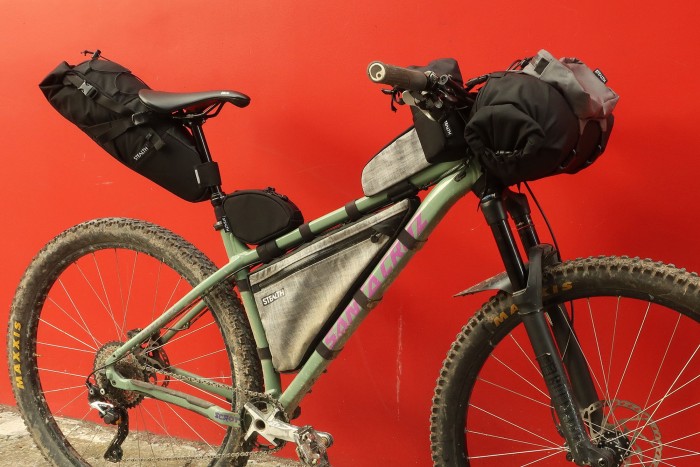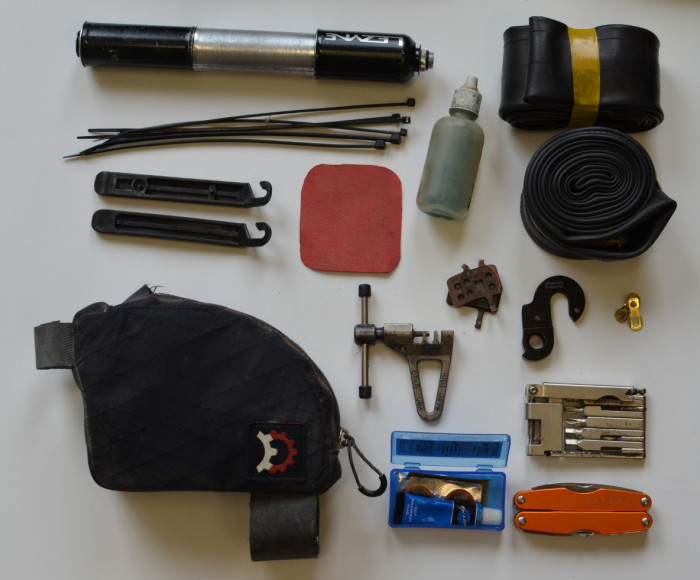What to pack
Make your ride safe, comfortable and fun with all the right clothing, gear and tools.
What you take on your ride will depend on how long, rough or remote you’re going. Here we bring you suggested gear lists for day rides and overnight/bikepacking trips, with plenty of suggested extras depending on your itinerary. Regardless of where and when you go, consider sharing gear – such as spares and tools – between your riding group.
Day rides
The beauty of a day ride is that you can travel light, but don't scrimp on the essentials, especially when it comes to your comfort and safety.
- Comfortable backpack – note that 30-litre capacity is the largest you’d want to carry. Other carrying options are detailed in the overnight/bikepacking trips section below
- Cycle helmet – a compulsory health and safety provision in Aotearoa/New Zealand
- Food – take more than enough to keep you fuelled up. That cafe or shop you thought would be open might not be
- Water (and water bottle/bladder) – though many rides have water sources where you can top up your bottle, always set off with sufficient supplies and work out where you can get more
- Sensible cycling clothes – pack several layers suitable to the conditions. We recommend a merino wool top in addition to a short-sleeve tops and an outer layer such as a fleece or shell. Padded lycra shorts are also essential for all but the shortest of rides
- Suitable riding shoes - bearing in mind that you might not always be on the bike and pedalling
- Cycling gloves – highly recommended, especially for longer rides
- Raincoat – essential if there's any chance of wet, cold weather, as are three-quarter length over-trousers, wool/merino socks and warm gloves
- Sunscreen/sunglasses – sun protection is vital at all times of year. Pack a sunhat too if you plan to spend time off the bike
- A buff/bandana - it will protect your neck from the sun and cold draughts
- Spares and tools - items like tubes, bike pump, tyre levers, lube and other bike tools appropriate to your remoteness and risk of mechanical failure
- Cellphone – carrying a fully charged cellphone is recommended for all rides, even remote ones where coverage is sketchy
- First aid kit – particularly if you're heading into rough or remote country
- Map/navigational aids – essential if there’s any chance of taking a wrong turn. Read more in our riding safely section
- Personal locator beacon/spot tracker – an excellent insurance policy for remote trails such as the Old Ghost Road, Timber Trail and St James Cycleway. The Mountain Safety Council website lists places in New Zealand where you can hire PLBs
- Torch, headlamp, bike lights – should your ride feature any tunnels or be likely to extend beyond daylight hours. Ensure you pack spare batteries
- Survival kit – for remote rides consider taking a basic survival kit. This may seem excessive but it could save a life in an emergency. Check out the Mountain Safety Council's advice on emergencies and survival.
Overnight/bikepacking trips
For overnight bikepacking adventures, you’ll need to take everything listed under day rides plus some or all of the extras below.
Weight is a big consideration. While a traditional cycle tourer or tramper might carry more than 20kg of gear, the modern-day bikepacker will pare it down to under 10kg. It's a good goal if you want to enjoy the ride, especially the hilly bits!
The biggest decision is whether you want to camp and cook, which requires an assortment of tent, cooker, utensils and food supplies. This may well be dictated by your itinerary. In some situations you may be assured of food outlets and accommodation along the way, in others you may not.
Let’s look closer at the gear list for overnight trips.

A great bikepacking set-up for overnight adventures (Stealth Bike Bags)
Camping gear
Carrying camping gear gives you the flexibility to stop for the night anywhere where tenting is permitted. It’s also economical. The disadvantage is the need to carry more gear.
- A tent (600–2000gm) offers good comfort and protection from wet weather and insects, and allows you to put your gear in with you. The lightweight ones are single skin and suffer from condensation, but at least the wet skin isn’t touching your sleeping bag. The more traditional double skin tents offer the most comfort
- A lighter weight alternative is a bivvy bag (300–600gm) that will protect you (but not your gear) from wet weather. However, they aren’t comfortable, you will get damp from condensation, and they are hot in summer
- Another alternative is the tarp or tent fly. These are lightweight (less than 400gm) and comfortable, but won’t stop the wind or sandflies/mosquitoes. An acquired taste, one might say!
- You'll also need a compact, lightweight sleeping bag and mat. An ideal pairing weighs less than 1kg combined.
Food, drink and cooking
It’s crucial that you carry enough food and drink to keep you going, and know where your next meal is coming from whether that’s a supermarket, café, or your own camping supplies.
- Carry high-capacity water bottles/bladders so you have as much water as you need
- Focus on high-energy food that is compact/unsquashable, such as muesli bars and scroggin
- As far as practicable, buy your supplies along the way rather than stockpiling them on the bike. It not only saves weight but also contributes to local economies
- Some riders may find sports drinks/electrolyte powders beneficial
- If you’re cooking meals, keep your cooking gear as lightweight as possible, including the stove, fuel, bowl, mug, cutlery and penknife
- Pack matches and/or a lighter and a micro-sized pot scrubber
- Opt for compact, high-energy meal ingredients, or dehydrated packaged meals such as Absolute Wilderness or Backcountry brands.
Clothing and other personal items
For overnight rides you’ll need to double up on a few things and factor in some extras:
- Spare socks, more merino underlayers (including long johns), spare shorts
- A warm fleece or down jacket, woolly hat/thin balaclava, full-finger gloves
- In addition to your rain jacket, don't forget three-quarter length over-trousers. You'll be thankful if the weather gets especially wet and cold
- Toiletries. Travel-sized toiletries and a tiny pack towel (or use your bandana)
- Toilet paper in a waterproof bag
- Chamois cream and lip salve to prevent and sooth chafing, blisters and other sores
- Head torch
- Earplugs in case you end up in a dorm or hut
- Cash as well as money card kept secure and dry.
Tool and other bike bits
Aim to squeeze all the small stuff into a tool bag:
- Spare tubes, preferably two, plus tyre levers and pump
- Puncture repair kit
- Spare brake pads and spare derailleur hanger
- Tyre boot
- Front and rear lights
- Chain breaker and spare chain link
- Bottle of lube
- Multi-tool
- Small fold-up knife with pliers, such as a Leatherman
- Small roll of duct tape, cable ties.

Tools and spares can turn your frown upside down (Jonathan Kennett)
Optional extras
- Dry bags or plastic bags for anything that must stay dry (bikepacking bags and backpacks aren’t generally waterproof)
- Lightweight nylon backpack for extras such as food supplies
- Jandals/flip-flops/hut shoes
- Water filter/purification tablets
- Insect repellent
- Spare batteries for any devices, and/or battery bank/solar charger
- Sarong
- Sleeping bag liner.
Here's one last tip from the pros - be be brutal in ditching non-essentials such as books, your lucky gonk and hair products. Share as much as you can between your group. Legend has it that some folks even snap their toothbrushes in half to save weight.
For tips on how to pack your bike, check out preparing for a bikepacking trip and the Kennett Brothers’ Bikepacking Aotearoa guidebook.
Lastly, if carrying a whole lot of gear isn't really for you then New Zealand’s bike tour operators are increasingly running a range of fully supported and guided bikepacking trips where luggage is transferred between overnight stops. Check out our list of tour operators here.
How to pack
Packing for an overnight trip is an art in itself. This excellent, short video by New Zealand’s Mountain Safety Council will help get you started.

